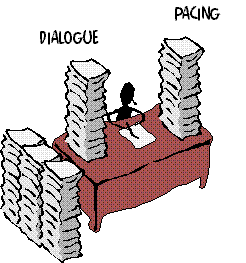
THE WRITERS' WORKSHOP on

DIALOGUE

Dialogue is the language of fiction. Successful dialogue moves the plot forward, develops point of view, and fleshes out characterization. All dialogue must have a purpose, unlike real life conversations. Banal talk, such as weather comments, will most likely have your reader:
falling fast asleep in the armchair,
turning the pages, or
throwing the book across the room...
... unless the boring dialogue serves a purpose.
Here's an example of a mundane request for coffee that does serve a purpose. In this case, a single guy is looking to get invited into his female neighbor's apartment.
Example: "You have a pot of coffee brewing. It smells awfully good to a kitchen-shy bachelor." (From "Friday Night", Susanne Marie Knight)
Components of Dialogue
words
punctuation
syntax
images
figures of speech
Here's an important tip on effective dialogue. Read it aloud to hear if it sounds realistic--not stilted and not inappropriate for the character. Also, don't hit the reader over the head with foreign accents and dialects. Something like:
Ach, I dinna know the wee bairn verry well
could cause the reader to hurl expletives deleted at you, the author. Remember: a little goes a long way to get the idea across.
Another aspect of dialogue is Pacing. Pacing refers to the speed at which your story takes place. For a faster pace, use more action and dialogue. For a slower pace, use more narration. If the character is upset, then sentences and dialogue should be even shorter, possibly even in fragments. This dramatically emphasizes the action and increases the pace.

WRITING EXERCISE
Imagine you are a young child playing in a wooded lot near your home. Your older brother or sister comes to taunt you, and threatens to destroy your favorite toy. Your parents will be gone for fifteen minutes and there is no one close by to hear you cry.
Begin from this premise and, using dialogue, try to reveal as much information as possible about the character and his or her situation.
Remember: the purpose of this exercise is to stimulate your imagination and your writing muscles. If you have any questions or would like to email your dialogue exercise, an addy is at the bottom of the page.
On to WRAPPING IT UP....